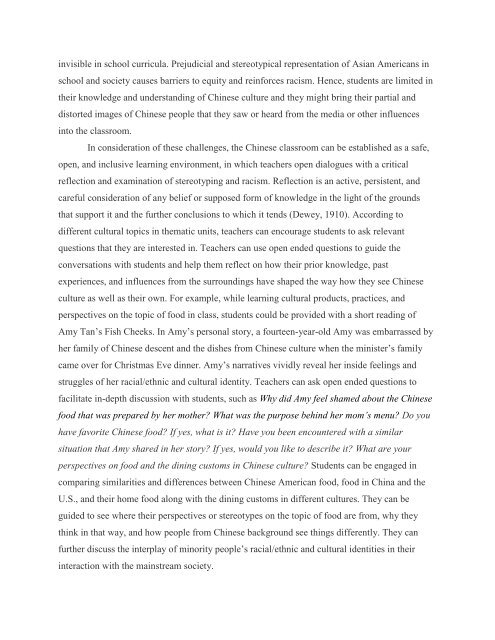K-12 Chinese Language Teaching, Issue 5
The K-12 CLT focuses on sharing experiences and exchanging ideas in teaching, research, and professional development.
The K-12 CLT focuses on sharing experiences and exchanging ideas in teaching, research, and professional development.
Create successful ePaper yourself
Turn your PDF publications into a flip-book with our unique Google optimized e-Paper software.
invisible in school curricula. Prejudicial and stereotypical representation of Asian Americans in<br />
school and society causes barriers to equity and reinforces racism. Hence, students are limited in<br />
their knowledge and understanding of <strong>Chinese</strong> culture and they might bring their partial and<br />
distorted images of <strong>Chinese</strong> people that they saw or heard from the media or other influences<br />
into the classroom.<br />
In consideration of these challenges, the <strong>Chinese</strong> classroom can be established as a safe,<br />
open, and inclusive learning environment, in which teachers open dialogues with a critical<br />
reflection and examination of stereotyping and racism. Reflection is an active, persistent, and<br />
careful consideration of any belief or supposed form of knowledge in the light of the grounds<br />
that support it and the further conclusions to which it tends (Dewey, 1910). According to<br />
different cultural topics in thematic units, teachers can encourage students to ask relevant<br />
questions that they are interested in. Teachers can use open ended questions to guide the<br />
conversations with students and help them reflect on how their prior knowledge, past<br />
experiences, and influences from the surroundings have shaped the way how they see <strong>Chinese</strong><br />
culture as well as their own. For example, while learning cultural products, practices, and<br />
perspectives on the topic of food in class, students could be provided with a short reading of<br />
Amy Tan’s Fish Cheeks. In Amy’s personal story, a fourteen-year-old Amy was embarrassed by<br />
her family of <strong>Chinese</strong> descent and the dishes from <strong>Chinese</strong> culture when the minister’s family<br />
came over for Christmas Eve dinner. Amy’s narratives vividly reveal her inside feelings and<br />
struggles of her racial/ethnic and cultural identity. Teachers can ask open ended questions to<br />
facilitate in-depth discussion with students, such as Why did Amy feel shamed about the <strong>Chinese</strong><br />
food that was prepared by her mother? What was the purpose behind her mom’s menu? Do you<br />
have favorite <strong>Chinese</strong> food? If yes, what is it? Have you been encountered with a similar<br />
situation that Amy shared in her story? If yes, would you like to describe it? What are your<br />
perspectives on food and the dining customs in <strong>Chinese</strong> culture? Students can be engaged in<br />
comparing similarities and differences between <strong>Chinese</strong> American food, food in China and the<br />
U.S., and their home food along with the dining customs in different cultures. They can be<br />
guided to see where their perspectives or stereotypes on the topic of food are from, why they<br />
think in that way, and how people from <strong>Chinese</strong> background see things differently. They can<br />
further discuss the interplay of minority people’s racial/ethnic and cultural identities in their<br />
interaction with the mainstream society.


